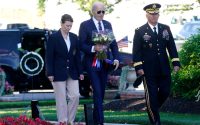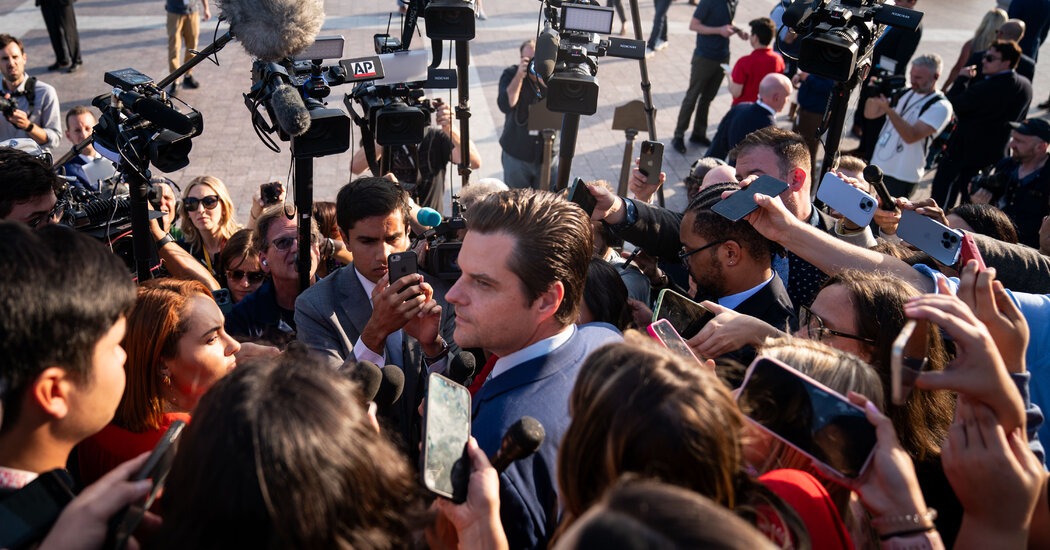Si Spiegel, War Hero Who Modernized Christmas Trees, Dies at 99
Before he became known as the father of artificial Christmas trees, Si Spiegel was a valiant Army aviator. In the closing days of World War II, he was piloting his B-17 Flying Fortress in an armada of 1,500 Allied bombers that pummeled Berlin. Struck by antiaircraft flak, two of the plane’s four engines lost power as Mr. Spiegel reversed course to return to England.
Rather than bail out over Germany and risk being captured as a prisoner of war — especially given that he was Jewish — Mr. Spiegel managed to crash-land in Soviet-occupied Poland. After being stuck there for weeks, he improvised a daring escape, using parts of his own plane to jury-rig another B-17 that had crashed nearby, then flying to an American base in Italy.
Mr. Spiegel, who died at 99 on Jan. 21 at his home in Manhattan, was among the last surviving American B-17 pilots of World War II, his granddaughter Maya Ono said. But Mr. Spiegel, a machinist by training, has another legacy: He was considered a pioneer of the mass-produced artificial Christmas tree.
The son of Jewish immigrants from Eastern Europe, he was raised in a religious neighborhood in Brooklyn and never had a Christmas tree, natural or artificial, in boyhood.
“I don’t necessarily think my grandpa associated himself with the trees and Christmas as much as he did with the machinery that he built to make the trees,” Ms. Ono said, “and then later in life, the systems he created to build a successful business and the relationships he cultivated.”
For Mr. Spiegel, becoming the king of artificial Christmas trees was a fluke, but his religion did play a part. After the war, he applied to be a commercial pilot, but was told he was barking up the wrong tree.
“They were blatant about it,” he said in an interview with the New York State Military Museum in 2010. “It wasn’t that they gave you some excuse. They told you, ‘We don’t hire Jews.’”
He briefly enrolled at City College of New York to become an engineer, but after his time at war he found the academic routine unsettling and stultifying. After a short stint as a radio announcer in New Mexico, he returned to New York.
Capitalizing on his early Army training, he was hired as a machinist but couldn’t keep a regular job because of his role as an organizer for the United Electrical Workers Union, which had been branded by its parent Congress of Industrial Organizations as being riddled with communists. (Mr. Spiegel was later president of Local 1709 of the Machinists Union, which belonged to the AFL-CIO.)
In 1954, he finally landed a permanent position with the American Brush Machinery Company, which was based in Mount Vernon, N.Y. He operated machines that manufactured brushes from wire and other materials for various industrial functions, including cleaning and scrubbing wood and metal finishing.
Artificial Christmas trees had been manufactured for decades, originally from the same animal hair bristles used for toilet brushes, then from aluminum and finally from different forms of plastic.
After American Brush unsuccessfully branched out into the Christmas tree business, Mr. Spiegel, by then a senior machinist, was tasked with closing the artificial tree factory. Instead, he began studying natural conifers, tweaked the brush-making machines to emulate the real trees and patented new production techniques.
In 1981, he became president of the renamed American Tree and Wreath Company, which began mass-producing 800,000 trees a year on an assembly line that turned one out every four minutes.
By the late 1980s, his company was generating annual sales of $54 million and employed 800 workers in Newburgh, N.Y., and Evansville, Ind. He sold the renamed Hudson Valley Tree Company in 1993, retired as a multimillionaire and turned his attention to cultural, educational and social justice philanthropy.
Si Herbert Spiegel was born on May 28, 1924, in Manhattan. His mother, Massia (Perlman) Spiegel, a seamstress and suffragist who was born in Bessarabia, named him after Issai or Isaiah, the biblical prophet who expressed the utopian dream that “neither shall they learn war anymore.” His Ukranian-born father, David, owned a hand-laundry in Greenwich Village.
After graduating from Straubenmuller Textile High School in Manhattan in May 1942, he worked operating grinding machinery for a manufacturer of industrial equipment for four months, then enlisted in the Army.
He graduated from aircraft mechanics school at Roosevelt Field on Long Island, but was frustrated: He wanted to fly planes, not fix them.
“How would I fight Hitler with a wrench?” he told The New York Times last year.
He was referred to Mitchel Field two miles away where he became an aviation cadet. During his training, he married Frankie Marie Smith in New Mexico; after the war, they divorced.
He was deployed to Eye, England, near the North Sea, where his diverse crew consisted of one other Jew, five Catholics, a Morman and a criminal who had been given a choice of going to jail or joining the Army.
Returning from his 33rd mission, the mammoth Feb. 3, 1945, air raid on Berlin, Mr. Spiegel managed to belly-land on a frozen potato field in Reczyn, Poland. While the crews’ families were informed that their kin were missing in action, they were held by Russian troops.
Uncertain what to do with putative allies, the Russians awaited orders from their superiors. But instead of staying put, Mr. Spiegel and his fellow officers surreptitiously removed an engine and a tire from their own plane to repair another hobbled B-17 that had crashed nearby. They bartered for fuel and, on March 17, the combined crews escaped to Foggia, Italy, where they were able to notify their families back home that they had survived. Mr. Spiegel led two more missions, then returned home to New York on Aug. 31, 1945, but he would go back to England and Poland for reunions of his crew from the 849th Bomb Squadron of the 490th Bomb Group.
Mr. Spiegel joined Pete Seeger’s Good Neighbor Chorus and in 1949 attended Camp Unity, a communist-affiliated summer camp in Wingdale, N.Y., where he met Motoko Ikeda, the daughter of Japanese immigrants who had settled in California. During the war, she and her family had been incarcerated in an internment camp in Wyoming; after, her parents returned to California, and she went to New York. She and Mr. Spiegel married in 1950. Ms. Spiegel, who became an artist, died in 2000.
Since then, Mr. Spiegel had lived alone on the Upper West Side, not far from where he was born.
He is survived by his daughter, Sura Kazuko Ono; two sons, Ray Spiegel and Tamio Spiegel; his brother, Lee; and five granddaughters.
Mr. Spiegel celebrated Jewish holidays with his children, but when they were young, a Christmas tree was a winter holiday staple — first a real one, then the best of his fake ones.
“They were pagan symbols,” he told The Times in 2021. “My kids liked them.”
His wife, too, upheld a cultural hallmark that wasn’t part of her upbringing: “Motoko was better at Jewish food than my mother,” he said. “She could cook in any language.”


